4 Greek and Roman Myths and Legends
Greek and Roman Myths and Legends
Myths can be conceptualized as ancient truths about the human experience and the natural world. Artists, poets, and writers throughout the ages have drawn upon these myths and legends as continued sources of inspiration. The Greek myths and legends predate the Roman myths by over 1,000 years. This section will highlight selected works of art that are complemented by the original source from the works of Homer and other writers. The polytheism of the ancient Greeks and Romans was reflected in nearly all spheres of nature, human life, and the planet. Controlling deities and guardians were connected with the heavens, skies, earth, and the seas. A great source of knowledge about mythology can be derived from the writings of Homer (The Iliad and Odyssey) and Ovid (Metamorphosis).
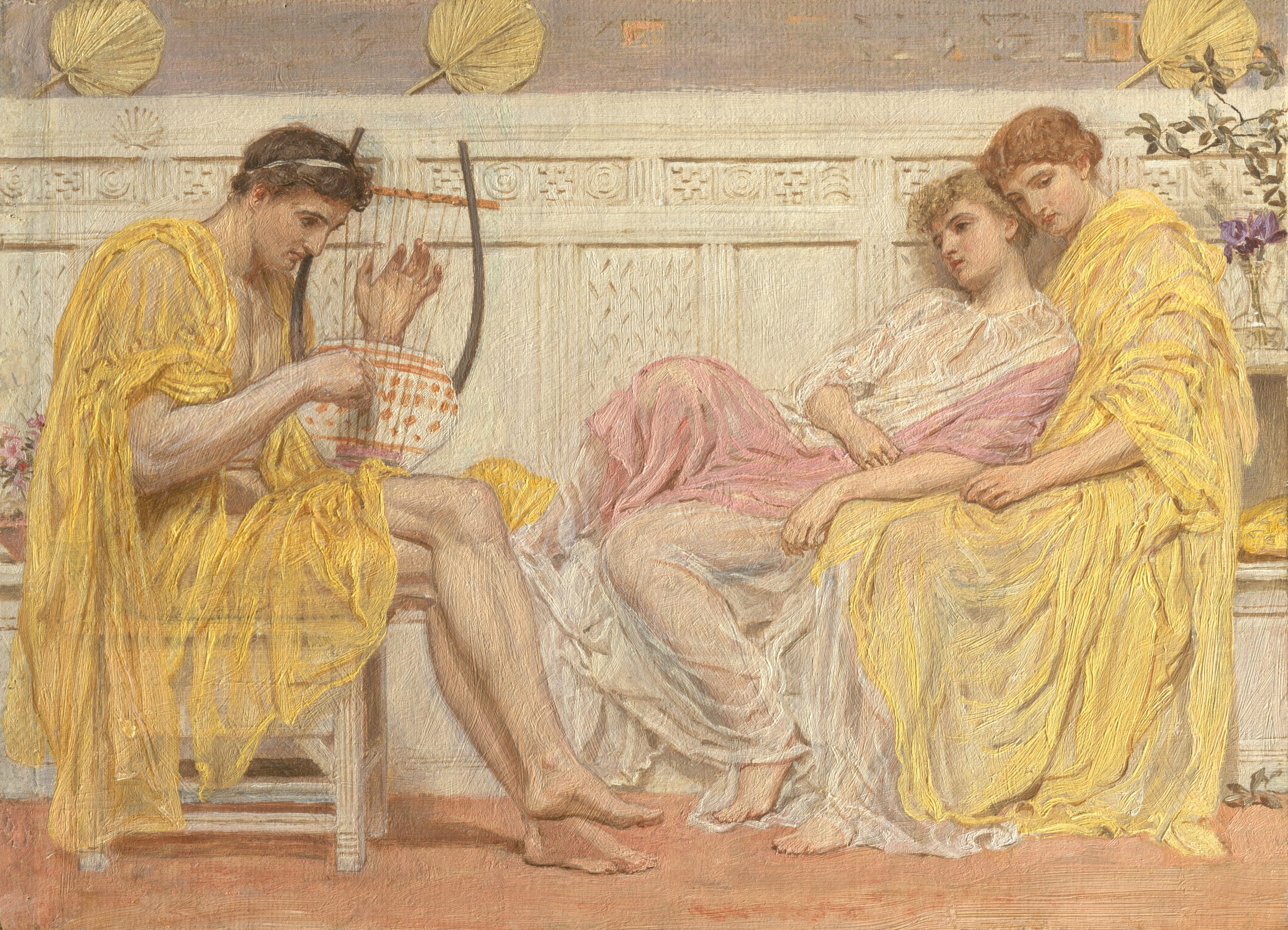
Courtesy: Yale Center for British Art, Paul Mellon Fund. “https://collections.britishart.yale.edu/catalog/tms:503” is licensed under CC0 1.0.
Creation Stories: The Beginning
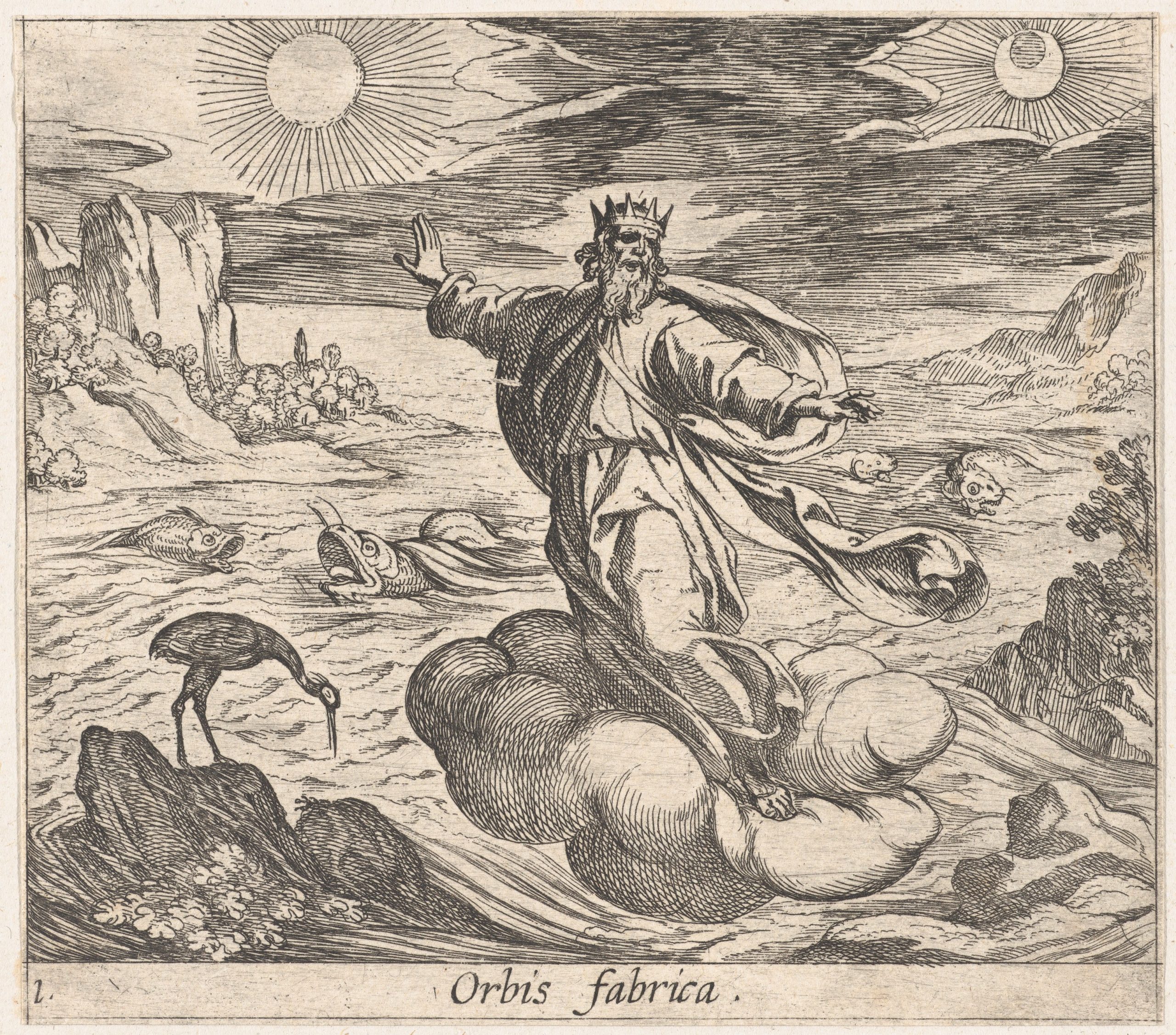
Courtesy: The Elisha Whittelsey Collection, The Elisha Whittelsey Fund, 1951. “https://www.metmuseum.org/art/collection/search/400952” is licensed under CC0 1.0.
From Words from the Myths by Isaac Asimov (1961/1969)
“The Greeks imagined that, to begin with, the universe was composed of completely mixed and confused matter. Nothing had any particular shape or form. The universe was merely a raw material out of which nothing had yet been made. The Greeks called this raw material Chaos.
The word “chaos mean, in Greek, an open gulf. The word “chasm, which means that also, come from the same roots as does chaos. The original chaos can be pictured, then, as something like outer space, but with none of the stars and planets formed yet. Everything existed merely as a kind of swirling and transparent vapor. Only emptiness, only a vast open gulf, would then seem to exist” (Asimov, 1969, p. 13).
The rich imagery found in Ovid’s epic Metamorphoses details the way order derived from chaos:
“Before the seas and lands had been created,
Before the sky that covers everything,
Nature displayed a single aspect only
Throughout the cosmos; Chaos was its name,
A shapeless, unwrought mass of inert bulk
And nothing more, with the discordant seeds
Of disconnected elements all heaped
Together in anarchic disarray.
The sun as yet did not light up the earth,
Nor did the crescent moon renew her horns,
Nor was the earth suspended in midair,
Balanced by her own weight, nor did the ocean
Extend her arms to the margins of the land.” (Book One, Metamorphoses, Ovid, trans. Martin, 2004,p. 15).
Composing Order from Chaos
In Book One of Ovid’s Metamorphoses, a description of the creation of world from order to chaos, sets the scene for the epic poem’s “sweep from the world’s beginning to the present day” (Martin, 2—4, p. 15). In Tempesta’s etching, the creator god “or kinder nature” (Martin, p.15) liberated the chaos and disentangled the elements to shape an enormous globe that was uniform throughout. New shores, springs, lakes, and rivers were added and all forms of animal and plant life began to appear. Then “he gave to man a face that is uplifted/and ordered him to stand erect and look/directly up into the vaulted heavens/and turn his countenance to meet the stars’ the earth, that was so lately rude and forms was changed by taking on the shape of man” (Book 1, Ovid’s Metamorphoses in Martin, 2004, p. 18). Students can compare creation myths from different cultures and highlight similarities and differences. Poems, stories, and novels that have been inspired by classic works from Ovid, Homer, and Sophocles can be read in tandem with an exploration of well- known works of art.
Ovid’s poetic masterpiece “Metamorphosis” inspired artists and writers throughout the generations. Ovid’s epic poem explores transformations not only in seasonal changes and the cycle of life but the mysterious and magical changes that humans and gods underwent. One of the four great ages was spring:
“Spring was the only season that there was,
And the warm breath of gentle Zephyr stroked
Flowers that sprang up from the ground, unsown.
Later-through still untilled—the earth bore grain,
and fields, unfallowed, whitened with their wheat;
now streams of milk, now streams of nectar flowed,
and from the green oak, golden honey dripped.”
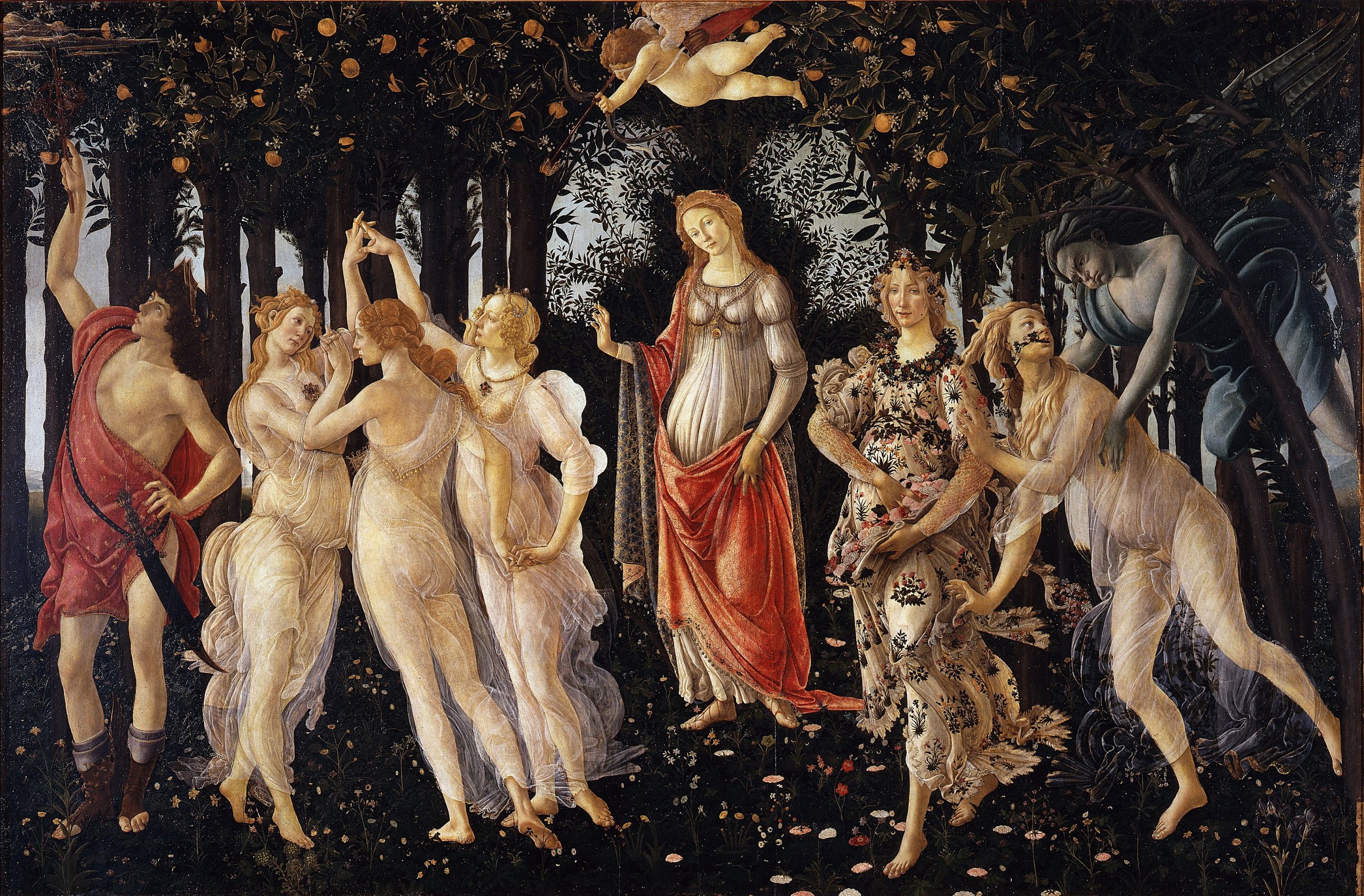
Courtesy: By Sandro Botticelli – http://www.googleartproject.com/collection/uffizi-gallery/artwork/la-primavera-spring-botticelli-filipepi/331460/, Public Domain, https://commons.wikimedia.org/w/index.php?curid=7963136
Sandro Botticelli’s Primavera illuminates the beauty and reverence for nature that is evident throughout Ovid’s Metamorphoses. In art and literature, spring is often depicted as a season of hope and renewal. In his painting, the west wind Zephyr is blowing a gentle breeze on Venus (centre figure), the three graces, and various other Roman deities.
Birth of Venus
Sandro Botticelli’s Birth of Venus is most often associated with Primavera. In the myth, it was said that Venus or Aphrodite (the daughter of Uranus and Gaea) arose from the ocean foam on a giant scallop shell. Isaac Asimov (1961) writes that “Venus is the one goddess whose name was given to an important planet. This is the planet commonly called the ‘evening star’ or the ‘morning star (depending on which side of the sun it happens to be). It is the brightest and most beautiful object in the heavens next to the sun and moon, and is far brighter than any star” (p.52). Sandro Botticelli’s skill and fine attention to detail is evident in the 138 plants and flowers painted. Although the complex meaning of Bottecelli’s paintings are a mystery, the paintings have long been associated with love, peace, flourishing, and regeneration.
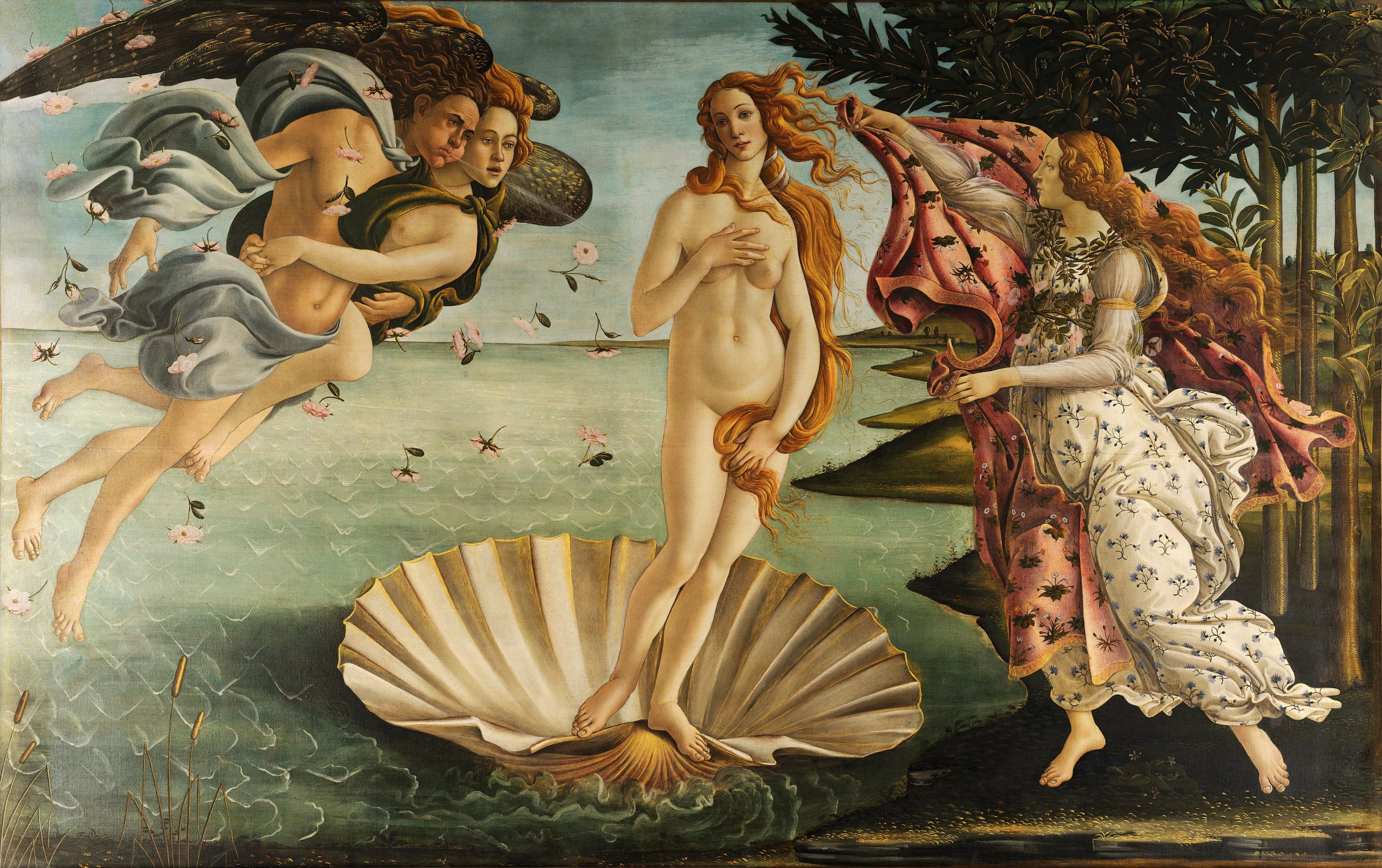
Courtesy: By Sandro Botticelli – Adjusted levels from File:Sandro Botticelli – La nascita di Venere – Google Art Project.jpg, originally from Google Art Project. Compression Photoshop level 9., Public Domain, https://commons.wikimedia.org/w/index.php?curid=22507491
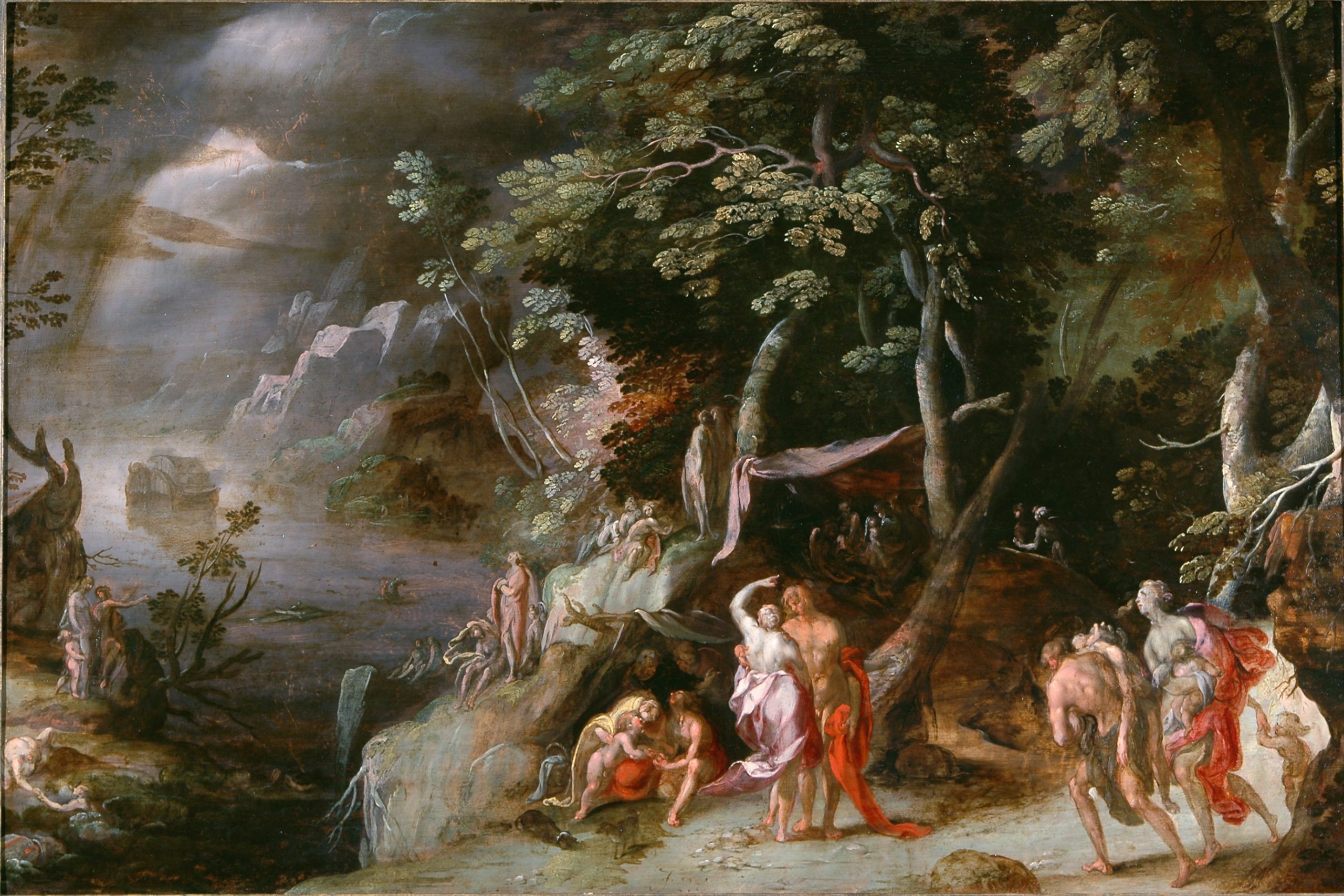
Courtesy: By Jan Nagel – Frans Hals Museum, Public Domain, https://commons.wikimedia.org/w/index.php?curid=17643710
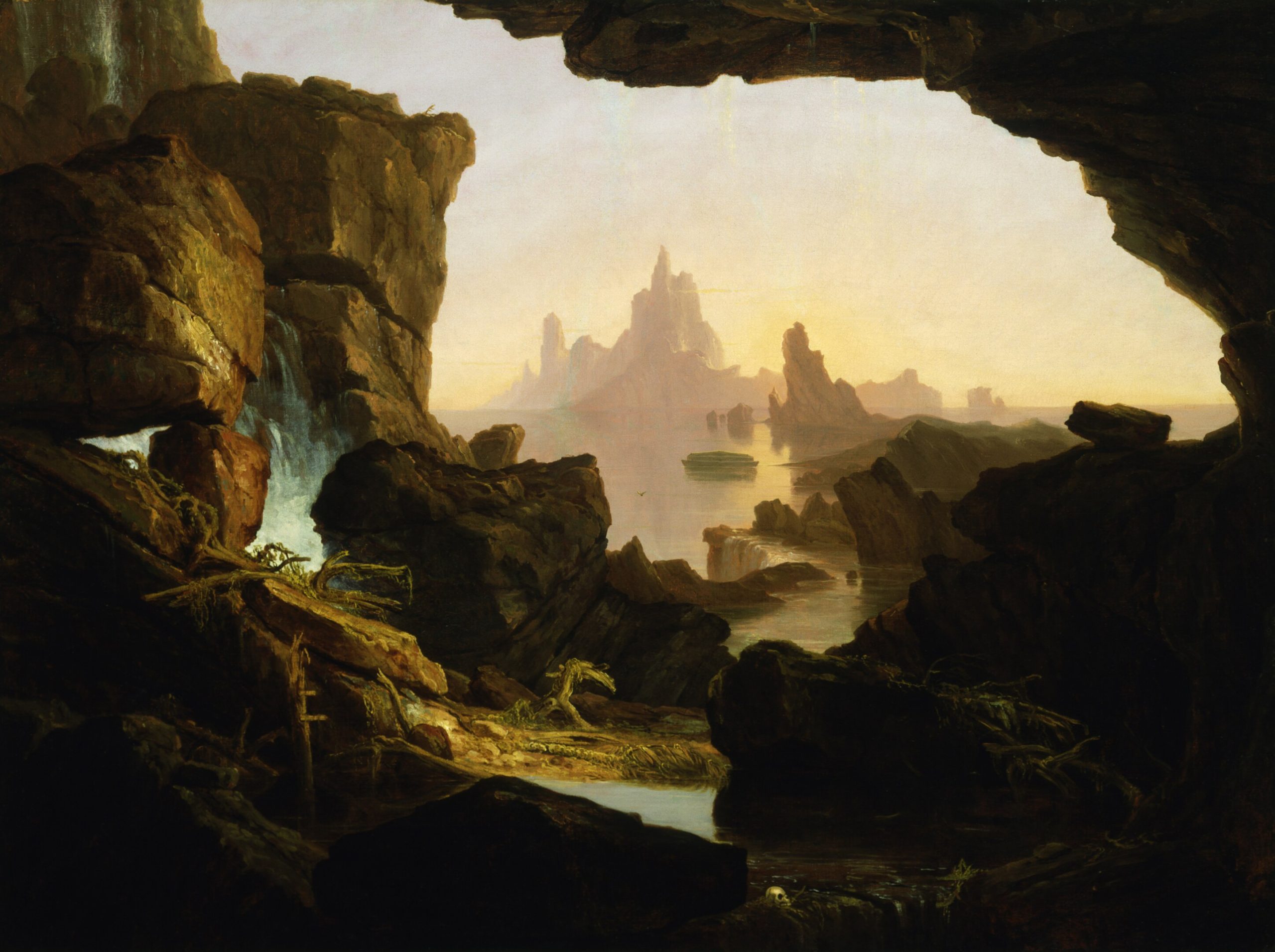
Courtesy: Gift of Mrs. Katie Dean in memory of Minnibel S. and James Wallace Dean and museum purchase through the Smithsonian Institution Collections Acquisition Program. “https://americanart.si.edu/artwork/subsiding-waters-deluge-5080” is licensed under CC0 1.0.
A Closer Look at the The Pantheon of Gods and Goddesses from Greek and Roman Myths: Selected Images and Texts
Zeus (King of the Gods) and Hera (Queen of the Gods)
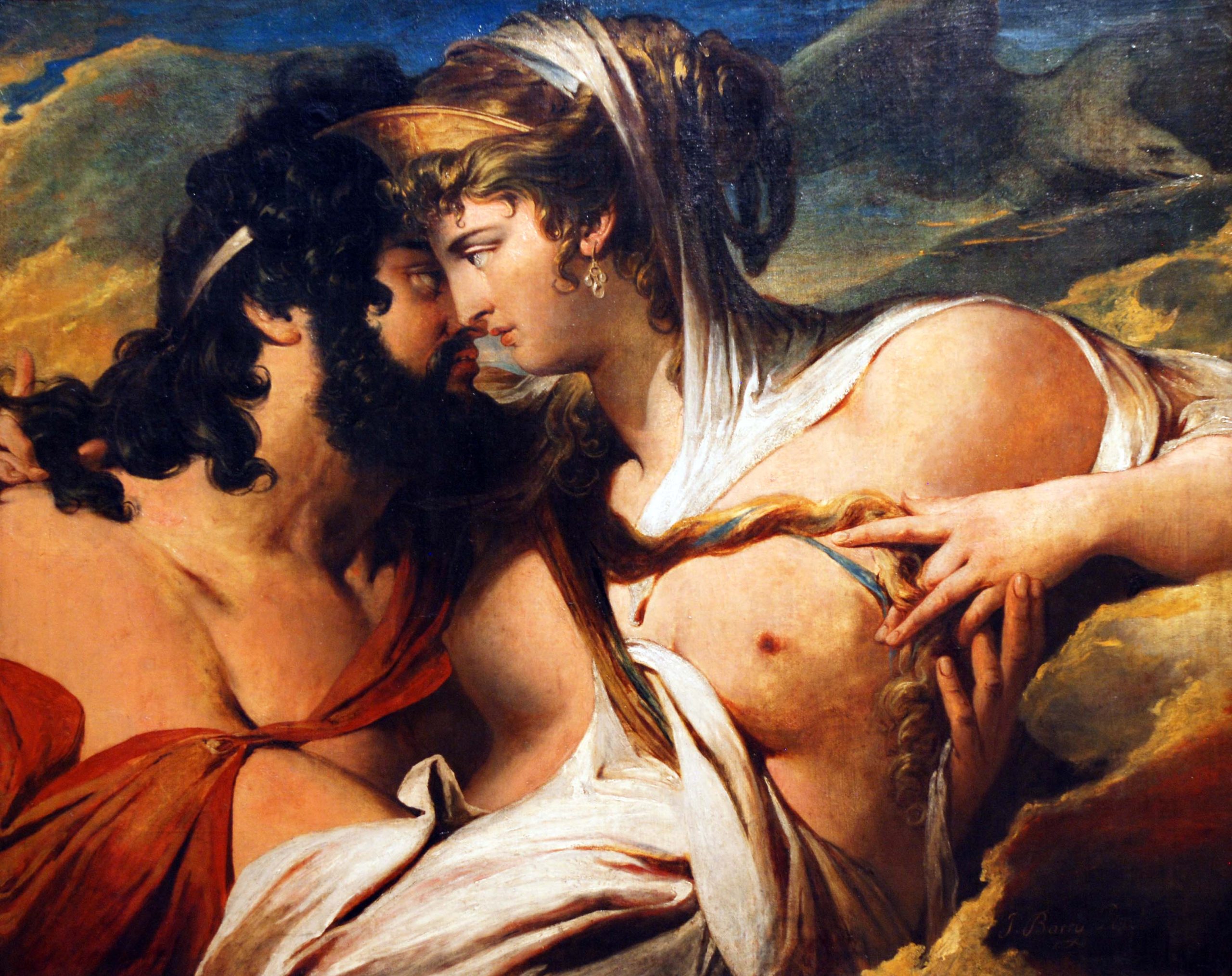
Courtesy: By James Barry – The Yorck Project (2002) 10.000 Meisterwerke der Malerei (DVD-ROM), distributed by DIRECTMEDIA Publishing GmbH. ISBN: 3936122202., Public Domain, https://commons.wikimedia.org/w/index.php?curid=147739
Greek and Roman Myths and Stories in Art and Prose, Poetry, and Verse
Many of the sources of the Greek and Roman myths and legends come from 8th -4th century B.C.E. (700 B.C.E. to 400 B.C.E.) writings. Some of these classical works that include Ovid’s Metamorphoses, Homer’s The Illiad and the Odyssey, the poems of Xenophanes (written between 570-475 B.C.E.) The Romans adapted many of the Greek stories to align with their own religious, culture, political systems, and social arrangements. The myth-tellers were the poets, dramatists, and philosophers. The popularity of mythology today suggests, according to writers like Isaac Asimov, Neil Gaiman, and Karen Armstrong, a need to find greater spiritual meaning in life. The interest in mythology and legends may also be a response to the increasing alienation and anonymity in an age of rapid mechanization and technological innovation, including more recent trends in Artificial Intelligence (AI). The histories of the gods with their rivalries, wars, births, deaths, marriages, and affairs reflect the daily struggles and challenges of humans. Mythology can engage, enlighten, challenge, and illuminate existential triumphs and tragedies of being human. The passions, fears, and dilemmas of mythic figures represented real and sometimes exaggerated personality traits of humans. Through the stories of the myths, an emotional and moral guide to living could be explored. Asimov (1961/1969) notes that a “religion grew up around the myths” (p.10); he further notes:
“After Christianity was established, the old religion died out, and Europeans no longer believed in the old Greek and Roman gods. Those gods and the myths about them lived on in memory, however.The old literature did not die; it was too great to be allowed to die. We read Homer’s The Iliad and Odyssey evn today. We read the great plays written by the Greek dramatists. We read Aesop’s fables and the historical and philosophical works of the Greeks and Romans. All are full of the gods and the myths….Traces of the Greek myths are to be found today in every European tongue, including English. For instance, a police car’s signal is a siren and a sea cow is a sirenian. A circus organ is a calliope; a jelly-fish is a medusa, and an Australian anteater is an echidna. We call out in a stentorian voice; listen to a kindly mentor or a bearded nestor; despise a hectoring bully” (Asimov, 1969, Words from the Myths, p. 11).
Mythological conceptions of the world and mythic characters are projections of human emotions and states of being. The Greeks viewed the earth as a woman (Gaia-queen of the earth domains) and the sky/heavens as a man (Ouranus-god of the sky). The children of Gaia and Ouranus were giants known as the Titans and Titanesses. The children of these primordial giants were Cronus and Rhea. Their reign did not last and in an epic battle, their own children (Zeus and his siblings) deposed the titans. The Titan Atlas was a brother of Cronus and in defeat, he was condemned to support the heavens on his shoulders (Asimov, 1961,p. 25). Zeus and the Olympian gods dwelled on Mount Olympus/ were the parents of Zeus and his siblings. The rule of the Titans under Cronus (Father Time) and Rhea (mother of the Olympian gods who saved her son Zeus) did not last and in an epic battle Zeus and his siblings the Olympian gods) deposed the Titans. They dwelled on Mount Olympus. Asimov (1961) writes that “the battle between the Titans and the Olympians may have been a symbolic description of the invasion of the land now called Greece by the first Greeks. These brought their gods with them, including Zeus, to displace or absorb the gods of the pre-Greek inhabitants.” (p. 37). Asimov further notes that a powerful, peaceful, and productive time in a nation’s history is often referred to as a “Saturnian age”(p. 37). The Olympian Gods as Wilkinson et al (2021) write “were all too human in their personalities and often lacked the lofty transcendence of the supreme beings in later religions. In a dramatic soap opera of fierce rivalries and petty spats, their actions were influenced bot by a desire to work for the good of humankind, but for their own selfish desires and whims”(p.30). While the gods and goddesses could be protective and generous, they could be capricious, impulsive, ruthless, and vengeful. These all too human frailties emerge throughout the Greek and Roman myths and legends. In many ways, the stories of the gods and goddesses provide a moral code of life lessons.
For more information please consult the reference listed below
Asimov, I. (1969). Words from the myths. Signet.
The Metropolitan Museum of Art Timeline of Art History
https://www.metmuseum.org/toah
Stories, Fables, and Legends
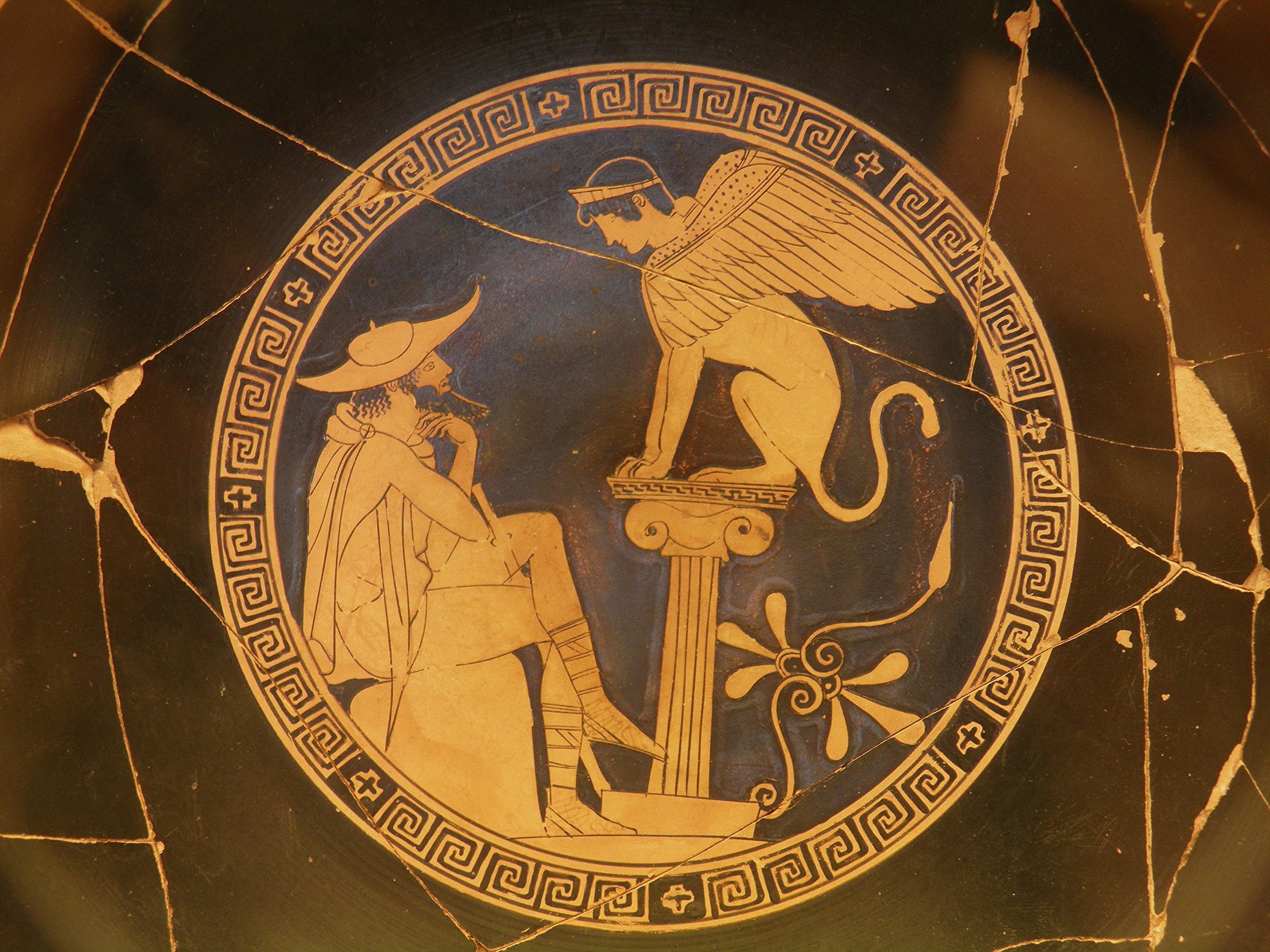
From Thomas Bulfinch’s Mythology: The story of King Oedipus, his fateful journey, and answering the riddle of the Sphinx:
“Shortly after this event the city of Thebes was afflicted with a monster which infested the high-road. It was called the Sphinx. It had the body of a lion, and the upper part of a woman. It lay crouched on the top of a rock, and stopped all travellers who came that way, proposing to them a riddle, with the condition that those who could solve it should pass safe, but those who failed should be killed. Not one had yet succeeded in solving it, and all had been slain. Oedipus was not daunted by these alarming accounts, but boldly advanced to the trial. The Sphinx asked him, “What animal is that which in the morning goes on four feet, at noon on two, and in the evening upon three?”
Oedipus replied, “Man, who in childhood creeps on hands and knees, in manhood walks erect, and in old age with the aid of a staff.” The Sphinx was so mortified at the solving of her riddle that she cast herself down from the rock and perished.
The gratitude of the people for their deliverance was so great that they made Oedipus their king, giving him in marriage their queen Jocasta. Oedipus, ignorant of his parentage, had already become the slayer of his father; in marrying the queen he became the husband of his mother. These horrors remained undiscovered,
till at length Thebes was afflicted with famine and pestilence, and the oracle being consulted, the double crime of Oedipus came to light. Jocasta put an end to her own life, and Oedipus, seized with madness, tore out his eyes, and wandered away from Thebes, dreaded and abandoned by all except his daughters, who faithfully adhered to him; till after a tedious period of
miserable wandering, he found the termination of his wretched life.” (Chapter 10, Thomas Bulfinch, Mythology, Oedipus and the Sphinx)
(https://www.online-literature.com/bulfinch/mythology_fable/10/)
To read more of the myths and legends adapted from the original sources and written by Thomas Bulfinch (1796-1867), please open the The Project Gutenberg eBook of Bulfinch’s Mythology, by Thomas Bulfinch.
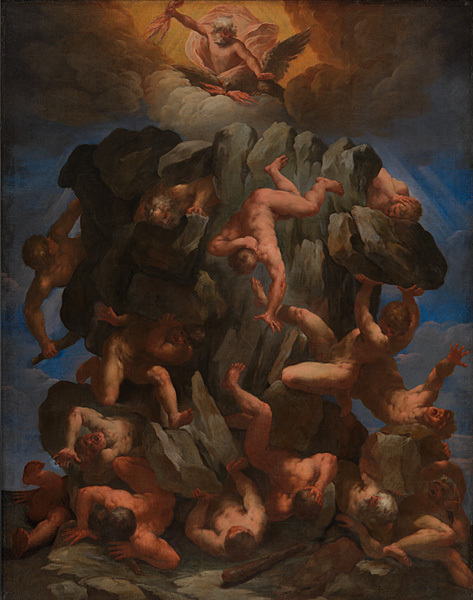
Courtesy: Statens Museum for Kunst. “https://open.smk.dk/en/artwork/image/KMSsp98” is licensed under CC0 1.0.
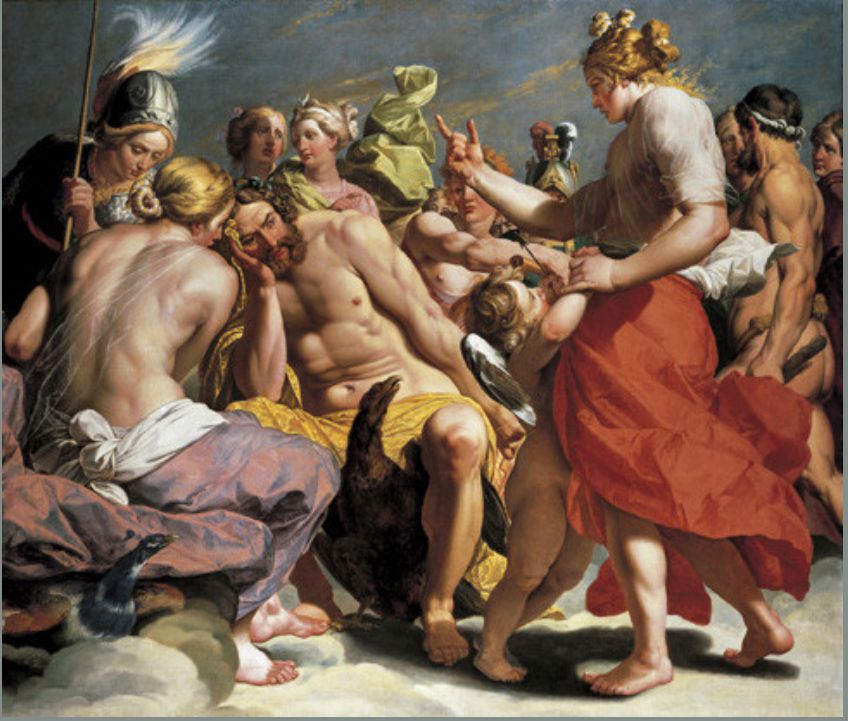
Courtesy: “https://www.sammlung.pinakothek.de/de/artwork/XR4MO31LQ1” is licensed under CC BY-SA 4.0.
In the painting, Zeus has gathered the Olympian gods (Juno, Minerva, Venus, and Mar) together to call for an end to the Trojan war. Venus (front with red skirt) disagrees and wishes to protect the Trojans.
The painting is based on a section from Virgil’s Aenedi (Book X, 1-14).
For complete details of the painting please open the link below: https://commons.wikimedia.org/wiki/File:Abraham_Janssens_-_Mount_Olympus.tiff

Courtesy: By Guercino – Unknown source, Public Domain, https://commons.wikimedia.org/w/index.php?curid=30026914
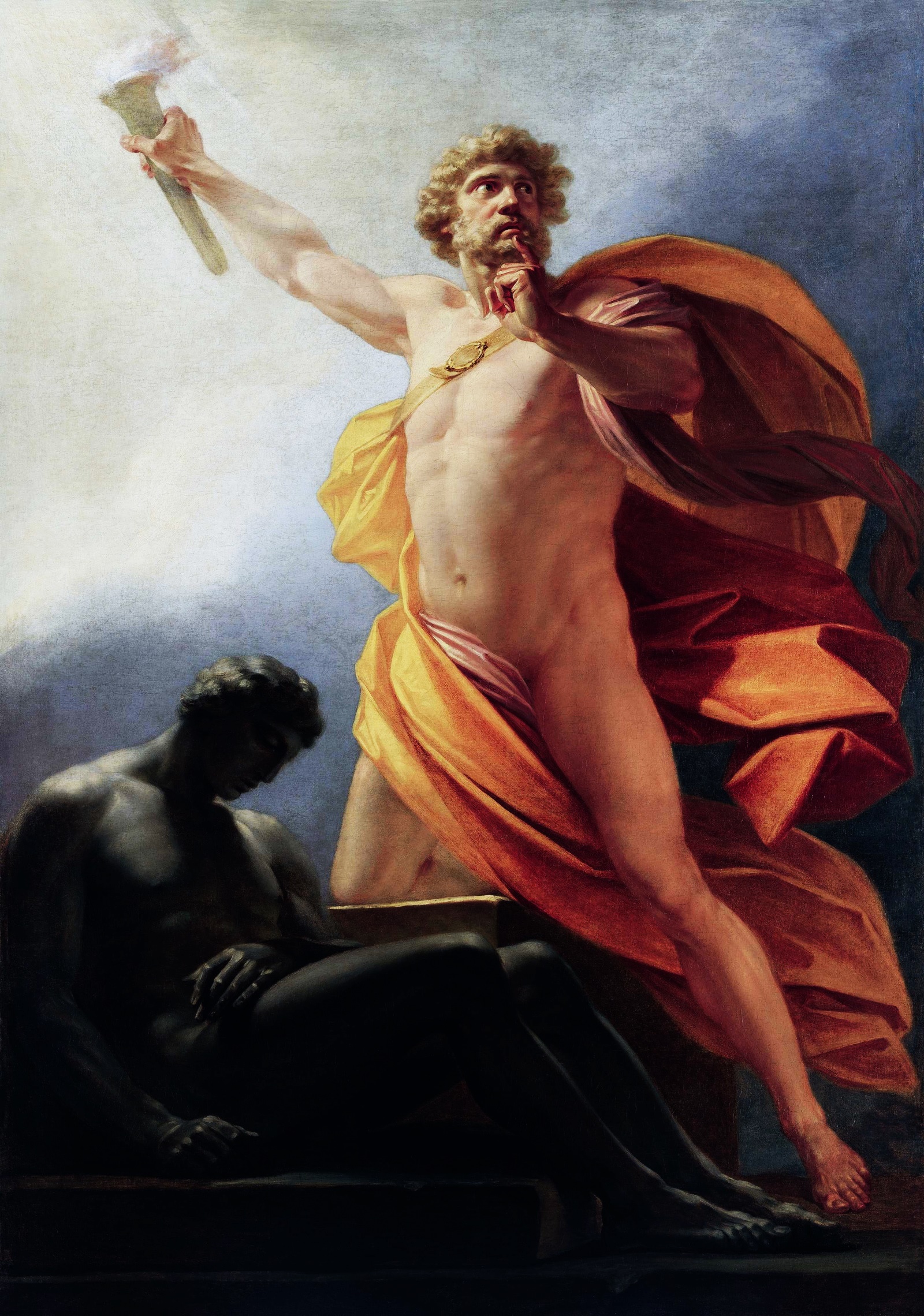
Courtesy: By Heinrich Füger – [1][2], Public Domain, https://commons.wikimedia.org/w/index.php?curid=175869
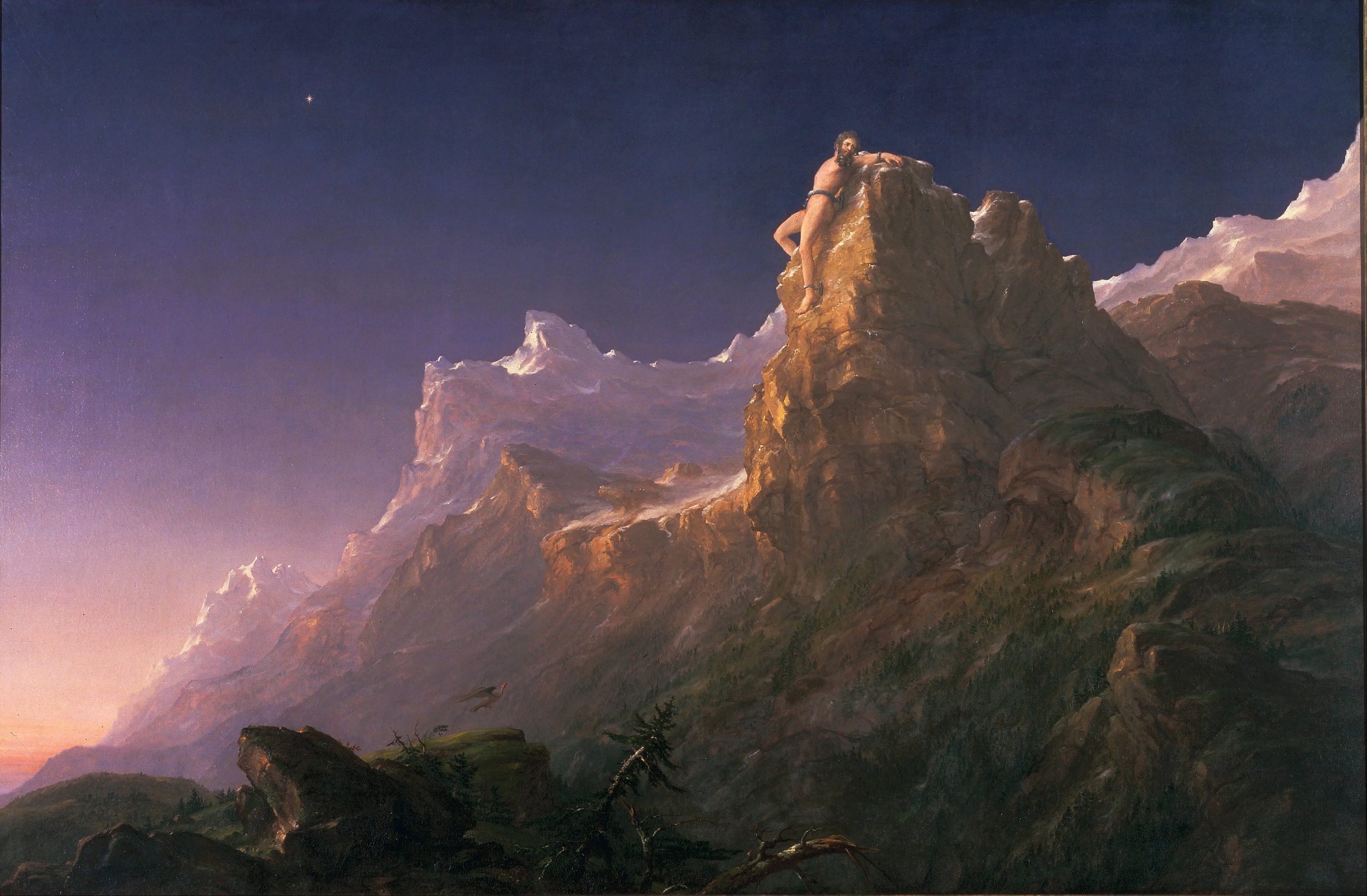
Courtesy: By Thomas Cole – ZwHNLCd-CKl3Tg at Google Cultural Institute maximum zoom level, Public Domain, https://commons.wikimedia.org/w/index.php?curid=21988027
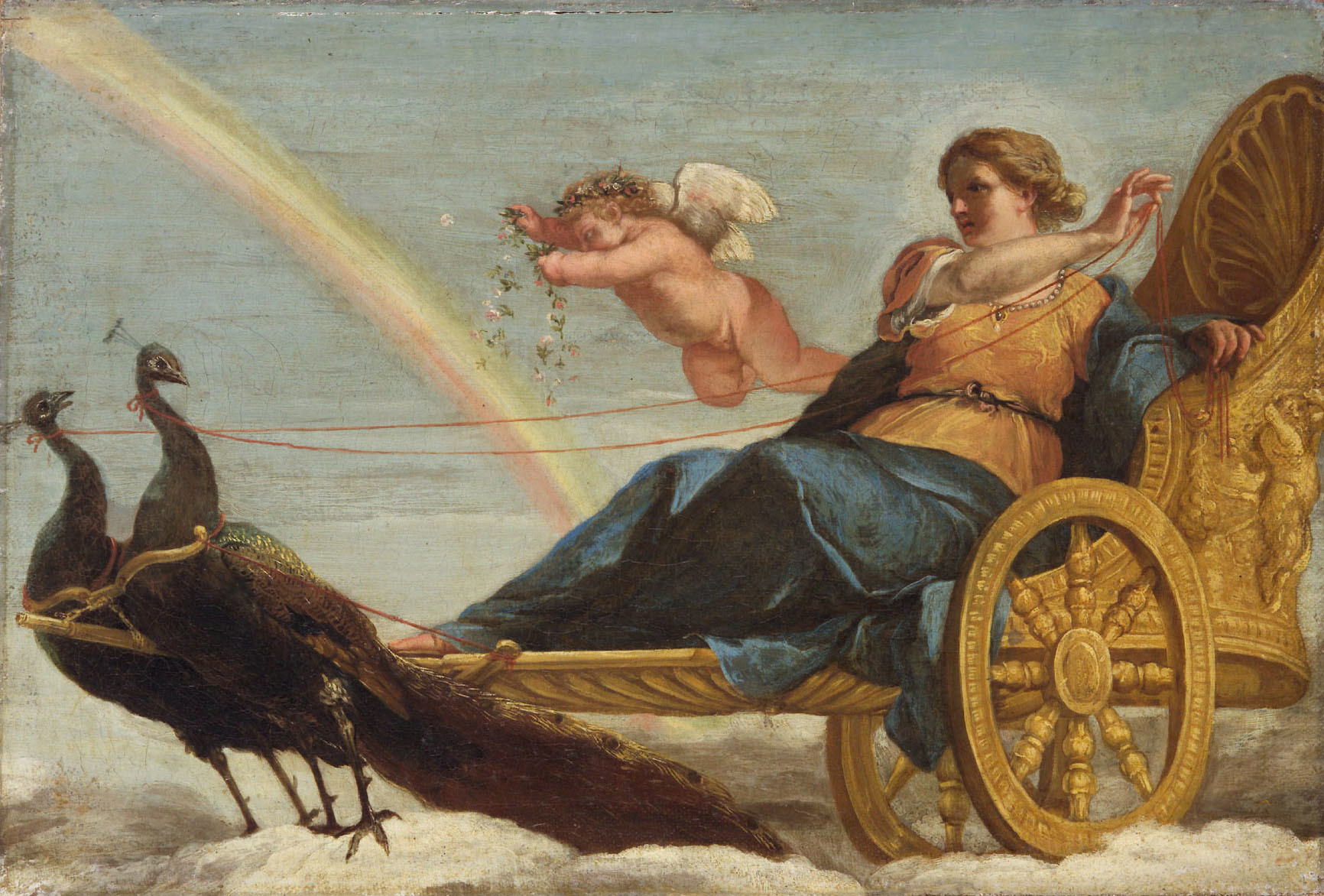
Courtesy: By Andrea Sacchi – Kunsthistorisches Museum, Public Domain, https://commons.wikimedia.org/w/index.php?curid=91941619
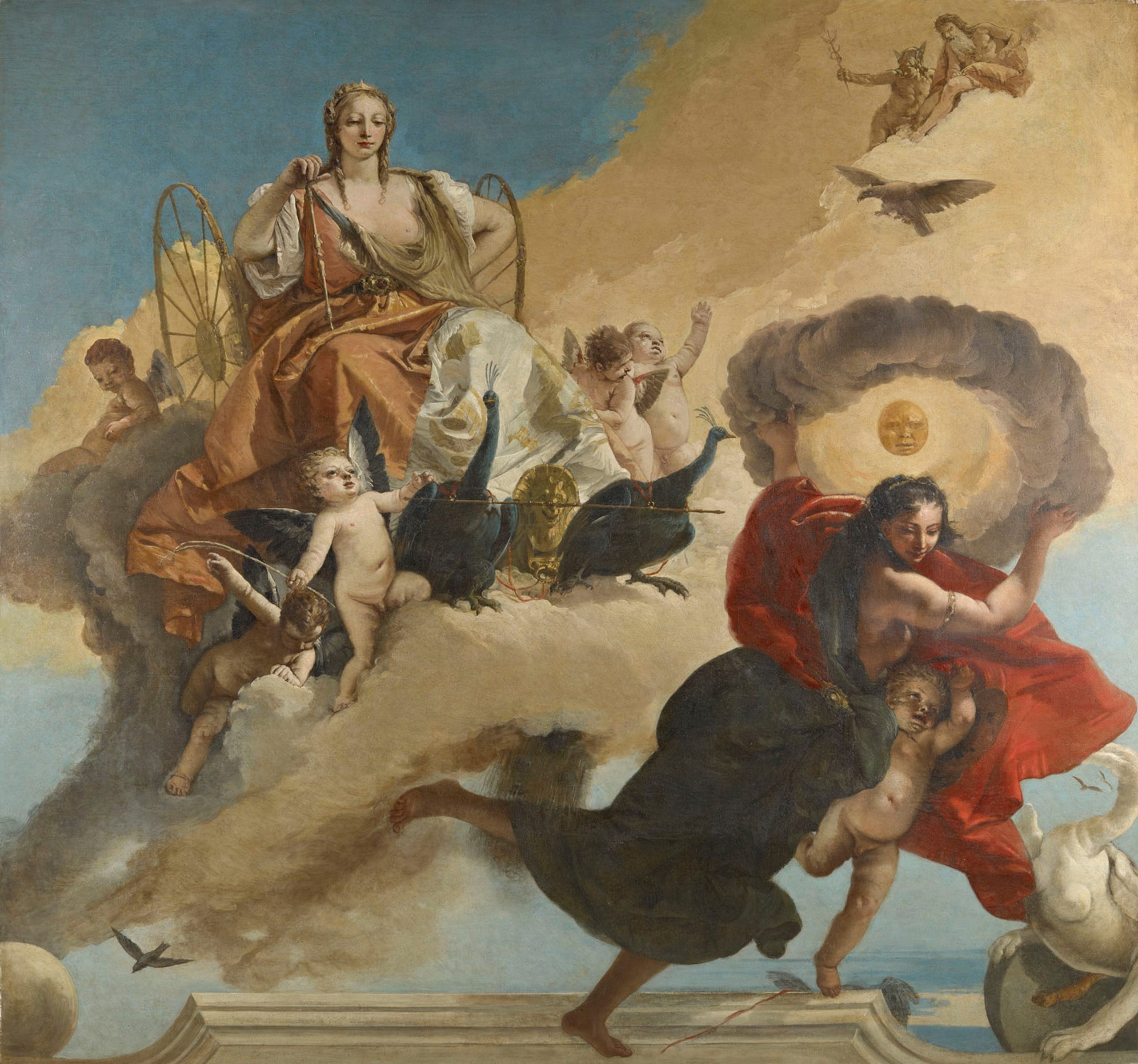
Courtesy: By Giovanni Battista Tiepolo – https://www.mfah.org/art/detail/20442, Public Domain, https://commons.wikimedia.org/w/index.php?curid=74390586
Mythopedia
https://mythopedia.com/library/homeric-hymns-evelyn-white-1914/12-to-hera
Ode to Hera
You are seated in a cerulean cavern, having the form of air, 1
Íra queen of all, happy one who shares the bed of Zefs,
You provide gentle breezes which sustain the soul.
Mother indeed of storms, attendant of the winds, all-begetting.
Apart from you life and generation cannot be found; 5
Mingled with the majestic air you partake of everything.
You alone hold sovereignty, ruling over all.
You are the stream which flutters down through the rushing winds.
And now you, happy Goddess, many named, queen of all,
Come with a countenance of kindness and joy. 10
The Mystical Hymns of Orpheus, trans. by Thomas Taylor, (1759-1835)
Source: Hellenic Gods
https://www.hellenicgods.org/orphic-hymn-to-hera
Web Gallery of Art
https://library.ncu.edu/c.php?g=643288&p=5206716
Open GLAM
Invidia was the personification of envy and hatred. In this powerful image, Athena pays her a visit. She was deathly pale and her skin had a green hue. She was considered to be Athena’s nemesis.
Juno sitting on the clouds addressing the peacock.
The Peacock and Juno
“The Peacock was greatly discontented because he had not a beautiful voice like the nightingale, and he went and complained to Juno about it. “The nightingale’s song,” said he, “is the envy of all the birds; but whenever I utter a sound I become a laughing-stock.” The goddess tried to console him by saying, “You have not, it is true, the power of song, but then you far excel all the rest in beauty: your neck flashes like the emerald and your splendid tail is a marvel of gorgeous colour.” But the Peacock was not appeased. “What is the use,” said he, “of being beautiful, with a voice like mine?” Then Juno replied, with a shade of sternness in her tones, “Fate has allotted to all their destined gifts: to yourself beauty, to the eagle strength, to the nightingale song, and so on to all the rest in their degree; but you alone are dissatisfied with your portion. Make, then, no more complaints. For, if your present wish were granted, you would quickly find cause for fresh discontent.” (Aesops Fables in Project Gutenberg). Retrieved August 28, 2020. Aesops Fables, G.K. Chesterton Aesop’s Fables illustrated by Arthur Rackham (1912) https://www.gutenberg.org/files/11339/11339-h/11339-h.htm
Courtesy: Wikimedia Commons. Gustav Moreau Museum, France
Gustave_Moreau_-_Le_Paon_se_plaignant_à_Junon.jpg (479×736) (wikimedia.org)
Gods and Goddesses in Art, Poetry, and Prose
Neptune (Poseidon, Greek) , God of the Sea.
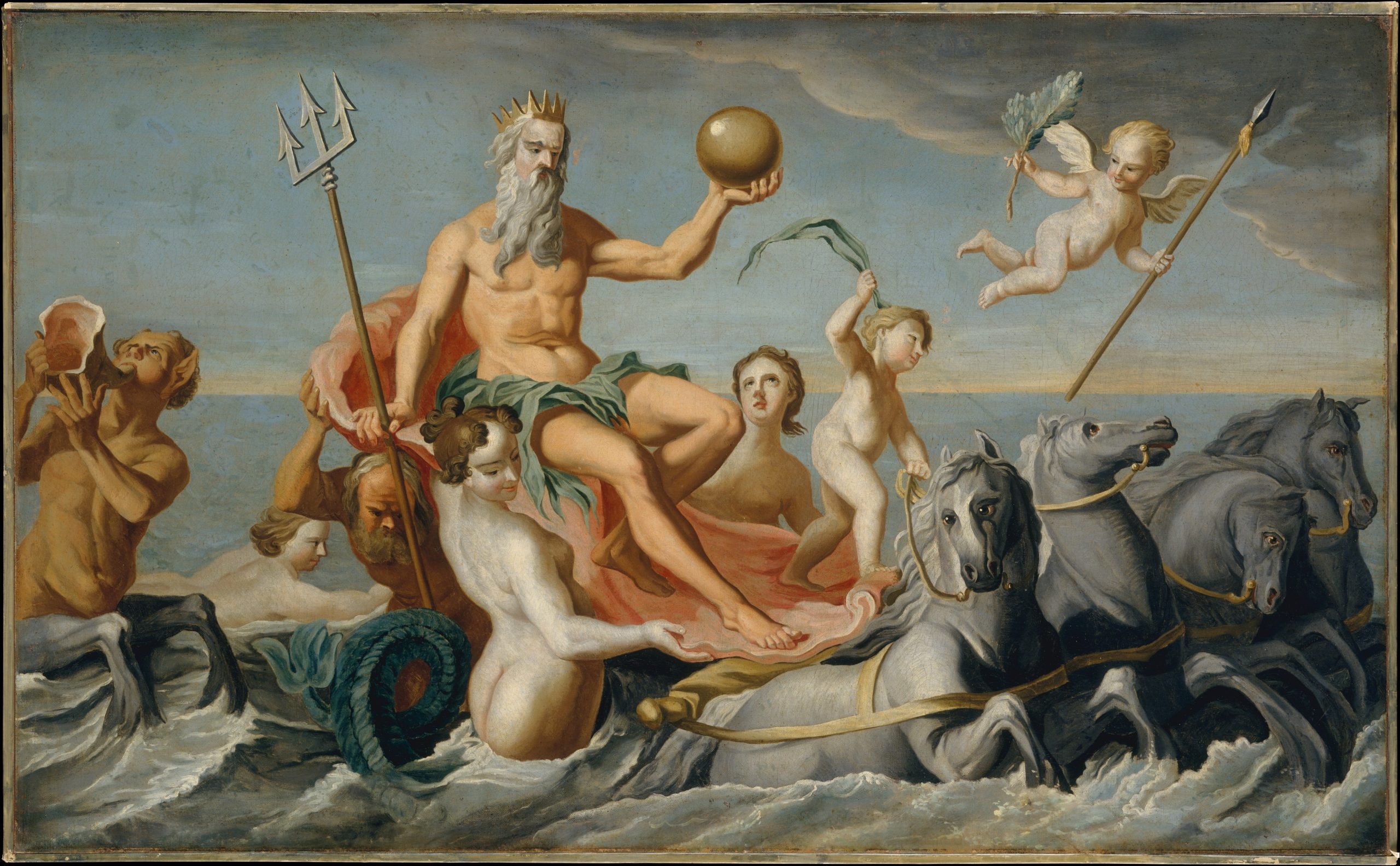
Courtesy: Gift of Mrs. Orme Wilson, in memory of her parents, Mr. and Mrs. J. Nelson Borland, 1959. “https://www.metmuseum.org/art/collection/search/10534” is licensed under CC0 1.0.
Note about the painting:
A gifted and brilliant artist, John Singleton Copley was only 16 when he completed this painting of Neptune and his retinue. Living along the New England Coast, Copley was connected emotionally, spiritually, and culturally to the sea. (Metropolitan Museum Notes). Please open the Met link below for biographical information about Copley.
John Singleton Copley (1738–1815) | Essay | The Metropolitan Museum of Art | Heilbrunn Timeline of Art History (metmuseum.org)
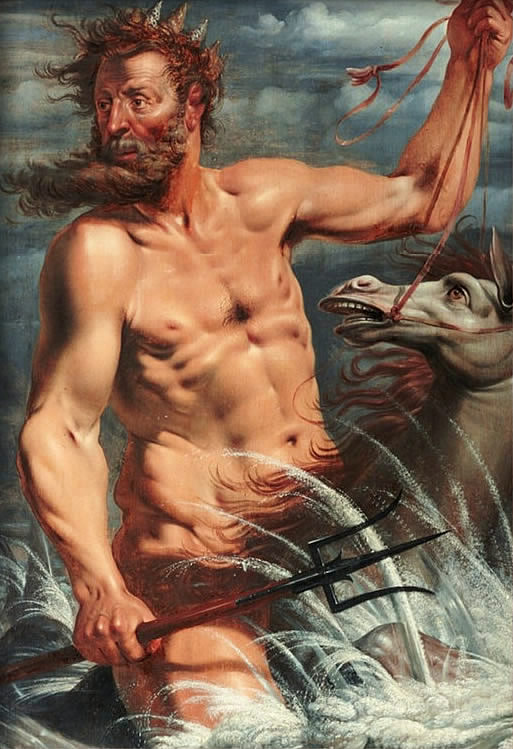
Courtesy: By Werner van den Valckert – not provided by the uploader: Shuishouyue (talk), Public Domain, https://commons.wikimedia.org/w/index.php?curid=30269613
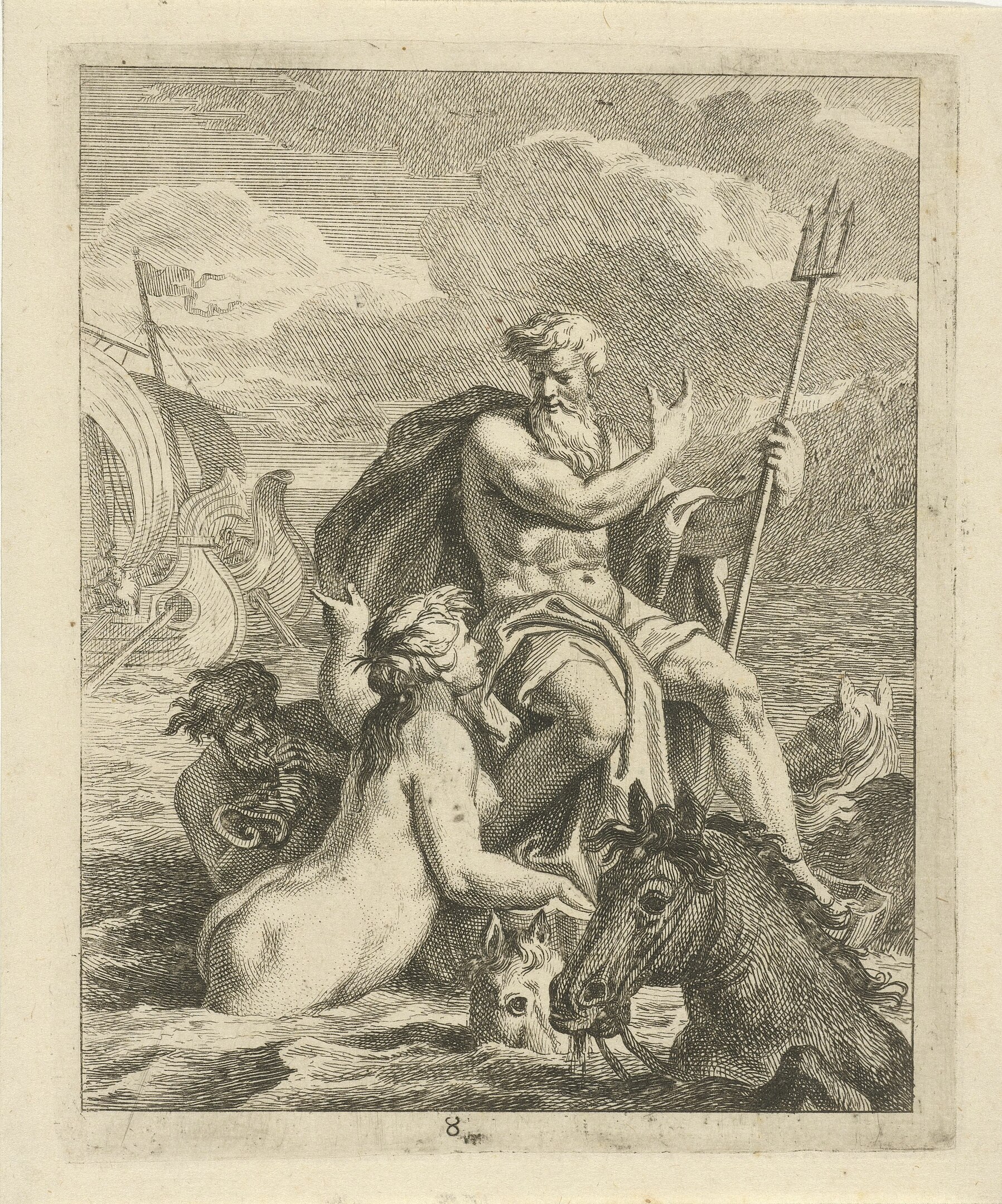
Courtesy: “http://hdl.handle.net/10934/RM0001.COLLECT.129036” is licensed under CC0 1.0.
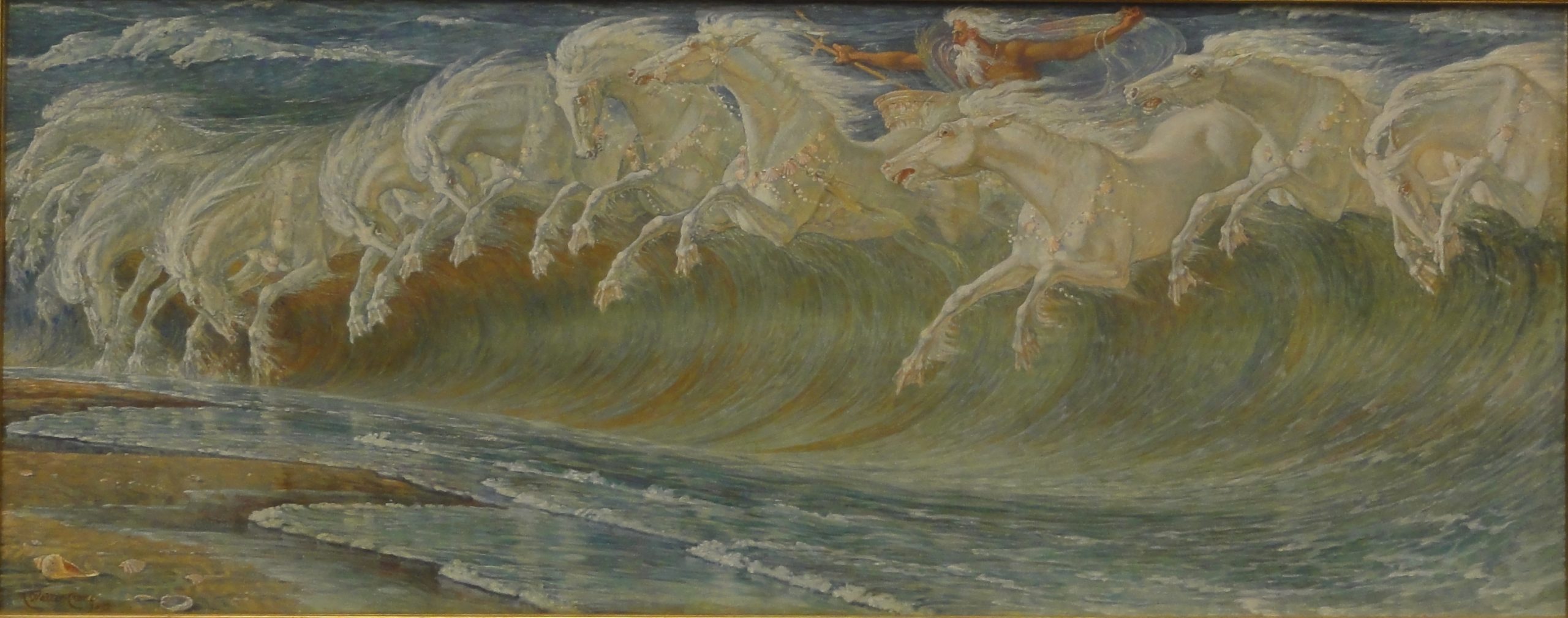
Courtesy: By Walter Crane – Self-photographed by Mattes, Taken on 10 March 2013, Public Domain, https://commons.wikimedia.org/w/index.php?curid=25062501
This passage from Homer’s The Illiad conveys the power and majesty of both the horses and the sea.
Poseidon dove and yoked his bronze-hoofed horses
onto his battle-car, his pair that raced the wind
with their golden manes streaming on behind them,
and strapping the golden armor round his body,
seized his whip that coils lithe and gold
and boarded his chariot launching up and out,
skimming the waves, and over the swells they came,
dolphins leaving their lairs to sport across his wake,
leaping left and right—well they knew their lord.
And the sea heaved in joy, cleaving a path for him
and the team flew on in a blurring burst of speed,
the bronze axle under the war-car never flecked with foam,
the stallions vaulting, speeding Poseidon toward Achaea’s fleet.–Homer, The Iliad, Book XIII
Major Gods and Goddesses from the Greek and Roman Pantheons
|
Greek God/Goddess
|
Roman God/Goddess
|
Description |
|---|---|---|
|
Aphrodite |
Venus |
Daughter of Zeus/Aphrodite/Venus was the Goddess of Love & Beauty/ married to Vulcan but was often unfaithful/often seen with her son Eros or Cupid/ instrumental in starting the Trojan War/Apple of Discord/often associated with swans, sparrows, and butterflies/myrtle plants/roses |
|
|
|
|
|
Apollo |
Apollo |
Son of Zeus God of the Sun/Brother of Artemis or Diana/ sun rays, a wreath, and a lyre are symbols for Apollo. |
|
|
|
|
|
Artemis |
Diana |
Daughter of Zeus/Goddess of the Hunt/Goddess of the Moon/Often featured with a moon crest crown or emblem/Although she hunted, she also protected animals/Although she was a virgin she assisted women in childbirth/ Contradictory Traits |
|
|
|
|
|
Ares |
Mars |
Son of Zeus and God of War/Important God for the Romans/Associated with Fertility/Conquest/the ancient Romans worshipped Mars as a fertility god also/often depicted riding a chariot driven by fire breathing horses/ a burning torch, helmet, shield, vulture, and eagle are symbols connected to Mars or Ares |
|
|
|
|
|
Athena |
Minerva |
Favoured daughter of Zeus/ Goddess of Wisdom & Crafts/Protectress/The owl is often associated with Minerva or Athena |
|
|
|
|
|
Hades |
Pluto |
King of the Underworld/Hades/ Abducted Proserphine, daughter of Ceres, Goddess of Agriculture. Tartarus was a region of Hades/the Underworld where criminals and monsters lived. |
|
|
|
|
|
Hephaestus |
Vulcan |
Son of Zeus; God of the Fire, metalworking, and the forge/one |
|
|
|
|
|
Hera |
Juno |
Goddess of Marriage; Married to Zeus/ Queen of the Gods/Often depicted with a Peacock |
|
|
|
|
|
Hermes |
Mercury |
Son of Zeus/ Messenger God/God of Commerce/Sometimes viewed as a Trickster |
|
|
|
|
|
Hestia |
Vesta |
Sister of Zeus; Goddess of the hearth and home/ Her vestal virgins were vital to the success of Rome/fire, cows, and pigs are often symbols associated with Vesta or Hestia. |
|
|
|
|
|
Kronos |
Saturn |
A Titan who led the revolt against his father Uranus (Ouranus) to control the universe. The Titans created the orderly movement and arrangement of the universe- the stars, the sun, moon, and the planets; Kronus is also known as “Father Time”/ was forced to regurgitate his children after he swallowed them/ Subsequently, Kronus was killed and deposed by his son Zeus. Kronos was also known as the King of the Elysian Fields, an idyllic place where the righteous dead lived. |
|
|
|
|
|
Persephone |
Proserpina |
Daughter of Demeter/Ceres/Wife of Hades/ Can only visit the earth for several months of the year/Associated with the pomegranate/important goddess for mystery cults |
|
|
|
|
|
Poseidon |
Neptune |
God of the fresh waters and the Seas; often depicted in a chariot driven by horses, sometimes accompanied by mermaid and mermen, protected sailors/the dolphin, horse, and trident or three pronged spear are symbols associated with Poseidon/Neptune |
|
|
|
|
|
Zeus |
Jupiter |
Sky and Thunder God; King of the Gods; Overthrew the Titans to secure the throne on Mount Olympus/one of the most promiscuous of gods/the main symbol for Zeus is the lightening bolt |
|
|
|
|
|
Demeter |
Ceres |
Sister of Zeus/ Goddess of Fertility/Land |
|
|
|
Minor Dieties
|
Greek God/Goddess
|
Roman God/Goddess
|
Description |
|---|---|---|
|
Dionyses |
Bacchus |
Son of Zeus; God of wine, vegetation; celebration and festivals; wandered the earth to help humans grow grapes for wine; grape vines, ivy, goats, and a staff with a pine cone head are symbols associated with Bacchus or Dionyses. |
|
|
|
|
|
Charites |
Gratiae |
Goddesses of Charm and Beauty; often depicted as the “three graces” |
|
|
|
|
|
Eris |
Discordia |
The goddess of conflict or discord; caused trouble if her warnings were ignored/played a role in the Trojan war/ “Apple of Discord” named after Eris/Discordia’ |
|
|
|
|
|
Eros |
Cupid |
God of Love and Desire |
|
|
|
|
|
Moirae |
Parcae |
Goddess of Fate and Destiny; similar to the Norns in Nordic Mythology |
|
|
|
|
|
Helios |
Sol |
A titan; god of the sun; cousin or uncle of Apollo and Artemis |
|
|
|
|
|
Horae |
Horae |
Goddesses of the Four Seasons |
|
|
|
|
|
Pan |
Faunus |
God of the pastures and woods; was often depicted as a goat eared and footed shepherd with a flute or small harp. |
|
|
|
|
|
Selene |
Luna |
Goddess of the moon, titan, and cousin to Apollo and Artemis |
|
|
|
|
|
Tyche |
Fortuna |
The goddess of chance and good fortune |
|
|
|
*Greek mythology predates Roman mythology by over 1,000 years. For more information about the differences, please open the link below:
References:
Asimov, I. (1961/1969). Words from the myths. Signet/New American Library.
Bulfinch, T. (1993). The golden age of myth and legend. Wordsworth Reference.
Butler, S. (1897). The illustrated Odyssey by Homer. Fall River Press (2018).
Campbell, J. (1968/2008). The hero with a thousand faces. New World Library.
Campbell, J. (1972). Myths to live by. Bantam Books.
Clarke, H.W. (1967). The art of the Odyssey. Prentice Hall.
Hamilton, E. (1942/1969). Mythology. Back Bay Books.
James, V. (2003). The genealogy of Greek mythology. Gotham Books & Melcher Media.
Homer, The Odyssey, translated by T.E. Lawrence (1888-1935). Arcturus Books (2020).
Lunge-Larson, L., & Hinds, G. (2011). Gifts from the gods: Ancient words and wisdom from Greek & Roman mythology. Houghton Miflin Co.
Martin, C. (introduction by Bernard Knox). (2004). Metamorphoses of Ovid. W.W. Norton.
May, R. (1991). The cry for myth. W.W. Norton & Co.
Morford, M. P.O., & Lenardon, R.J. (1971/1985). Classical mythology. Longman.
Smithsonian Museum of American Art and the Renwick Gallery: Myths in Art and Words (2023).
https://smithsonianeducation.org/educators/lesson_plans/myths/index.html
Wilkinson, P. (2019). Myths and legends: An illustrated guide to their origins and meanings. DK Penguin Random House.
Wilkinson, P. et al (2021). The mythology book: Big ideas simply explained. DK Random House.

